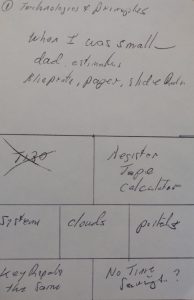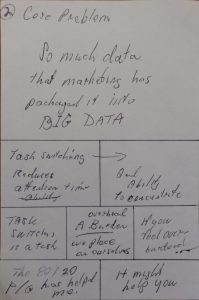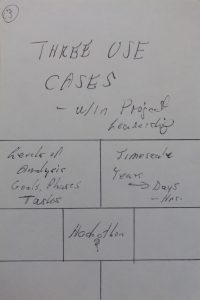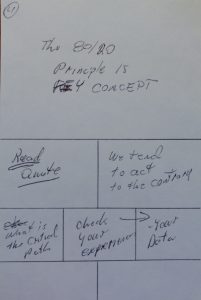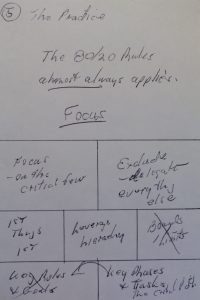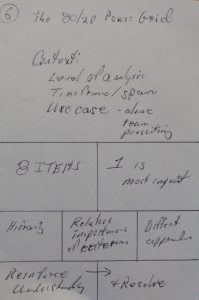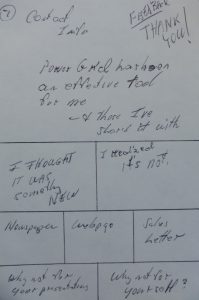This article is adapted from two “TED Talk” presentations at the Ohio Facilities Construction Commission Conference, August-September, 2017. [Presentations found here: For PDF copies of presentations click here.]
How can you lead a complex, construction project with thousands of requirements with a one-page 80/20 Power Grid™?
We live in a world where the volume of useful, relevant, interesting information available at our fingertips, within earshot, at a moment’s glance, vastly exceeds our capacity to intake, digest, consider, process, reflect upon and take action upon. Samuel Johnson writes,
“The present age… may be styled, with great propriety, the
Age of Authors; for, perhaps, there was never a time when
men of all degrees of ability, of every kind of education, of
every profession and employment were posting with
ardor so general to the press…”
Few would argue with Mr. Johnson, who wrote that in 1753.
Type the phrase [exponential growth of digital information] into a search engine and over 3.1 million results pop up in 0.64 seconds.
What would Mr. Johnson make of such ardor?
Information is being created at an increasingly alarming rate. Citing any one statistical measure does injustice to the very most important of the others. Any one statistic is quickly out of date. The alarming measures of exponential growth from just a decade or two back, seem to us from the vantage point of the present as charmingly quaint.
Yet, 80-96% of people do not have an effective strategy and set of techniques for dealing with these quantum leaps from thousands-per-X to billions-per-Y.
I am about to share with you a strategy, a technique, a tool, to help you win the battle—the war—for your attention. For your sanity. For your success.
I will describe a low-tech, technique that can help you do just that.
It is a technique that can help you identify and focus upon the most important aspects of your project—wherever you are in your project and wherever you are in the real world.
It is a tool that can help to quickly communicate the relative importance and urgency of these aspects to project stakeholders, whoever they may be.
These aspects include, for starters, project goals, phases and tasks across the lifespan of your project, the next few months, weeks, days and even hours or minutes.
Technologies and Principles
All of my adult life I have worked with systems and software projects.In college though, my first real job was as a construction laborer.
I was a dues paying member of the International Laborers Union of North America (ILUNA), Local 125 (Youngstown, Ohio).
I learned about projects from the ground up. From below the ground up, in fact. In addition to cleaning out sanitary manholes, I helped bricklayers lay bricks, concrete finishers finish concrete, carpenters put together structures, go-for this, go-for that as well as being a general surrogate for abuse that anyone wanted to heap on my dad.
You see, my dad was the project superintendent for a construction company. When I was small, he would often work on bids at the dining room table. The table would be covered with blueprints, yellow legal pads, pencils and his slide rule. This slide rule.→
Technology evolves.
One Sunday, he brought out a calculator. It had a register tape and a digital display. The latest and greatest Texas Instruments something-or-other.
He put the TI through a quality control check, comparing its results with his baseline slide rule. Finally, he was convinced that the TI could do the job.
He would ten-key his inputs, annotate the register tape with what the various factors of production were, and staple each cost calculation to a yellow sheet, to which he added his explanatory notes.
Progress. Of course, we are many generations past those Sundays.
We have complex resource planning systems, cloud portals, Smart phone apps, drones to inspect things way up in dangerous places, and pocket beacons to track workers way down in dangerous places and — all sorts of TECH to enable us to do more, better, faster, stronger, higher — to infinity and beyond!
Yet, the key outputs of these systems — the ultimate purpose of these wonderful, time-savings extravagances — have not changed much if at all.
An income statement still still shows a profit or a loss. A balance sheet still shows net worth. Changes in cash flow, just that. Work breakdown schedules (ought to) show the critical path. And, a job cost summary (ought to) show the actuals versus estimates, projected costs and time to completion.
These remain the “changeless core,” to borrow a Stephen Covey phrase, of effective project leadership.
So, we have more and better and tools to give us more information. Is it better information or simply more data?
And, at the end of the day, have the multitude of time-saving tools, devices and apps saved you any time?
Do you have more time than you used to?
That, I believe, is the core problem.
The Core Problem
The key scarce, limiting resource in any complex project is management attention.
There is an overwhelming amount of data generated about and by various human, material and technological resources.
An exponential increase in data means increasingly less attention time available for the average bit of data.
Since we have less time to consider any one bit of data, we often trick ourselves that multitasking enables us to handle multiple things at a time.
The demand to multitask is as relentless as it is wrongheaded. Science shows that multitasking is actually continual task switching and that task switching is itself a task. (See, for example, Psychology Today, National Public Radio, Forbes, or your Amazon Bookshelf.)
Multitasking is an overhead burden we place upon on ourselves—reducing our ability to focus deeply on any one thing for a long period of time.
I came up with the 80/20 Power Grid™ idea to help me with all of that. And, it has.
Those that I have shared this with agree. Perhaps, it can help you too.
Three Use Cases
I use the 80/20 Power Grid™ in many ways. In terms of project leadership, I would like to share three use cases.Before describing these use cases, let’s talk a moment about the three levels of analysis: Goals, Phases and Tasks.
Although you can use the 80/20 Power Grid™ with any level of analysis, I have found that it is most useful when it is used with only one level of analysis at a time.
Likewise, you can apply the concept to any time frame of analysis but, again, I have found that it is most useful when it is used with only one time frame at a time.
For example, you may want to work with goals across the lifetime of a project, important project phases within the next few months or critical tasks in the next few weeks or days or even hours.
So, with that, let’s turn to the three use cases.
The first use case is when you as leader need to spend the solitary work of determining where you as leader should focus your energy. Whether you journal first thing in the morning, meditate in some fashion or simply think about things in your own fashion, you can bring this tool into your process.
The second use case is when you with your project team—however you define that—are collectively, cooperatively brainstorming about where to focus management team energy. Again, however your team meets virtually or in person, this technique can facilitate your process. Yes, you can use your solitary work to jump start this group work.
And the third use case is when you and your team need to convey the status, priority or relative urgency of project priorities to various stakeholders—such as the contracting authority, suppliers, lenders / investors, work crews / trade union agents, the media and so forth. And, if you did bring your solitary work to the second use case, that is actually a handy application of this third use case.
The 80/20 Principle
“A minority of causes, inputs or effort
usually lead to the majority of the results,
outputs or rewards.” –Richard Koch
As you might expect, something called the 80/20 Power Grid™ rests heavily upon the 80/20 Principle itself.
The 80/20 Principle, first identified by the Italian scientist, Vilfredo Pareto, is something most everyone knows—the importance and prevalence of which, most everyone minimizes.
If you would like an entertaining, thoughtful, idea-inspiring deeper look or even just a brisk refresher, you could do no better than to take in Richard Koch’s series of books on the 80/20 principle.
For our purposes, simply put: 80% of your project’s success depends on 20% of the tasks in your project.
Think of your project’s Critical Path. Do your own analysis / math. My bet is that far less than 20% of the tasks in your project — or database of projects — are actually on the critical path.
We live in a democratic—lower case “d”—society. We tend to believe that since all people are created equal, all things—goals, phases and tasks—are equal as well.
They are not.
In short, for practical purposes as project leader, 4/5ths of your project is largely irrelevant. If you prefer, consider that you, as project leader, should be delegating at least 4/5ths of your project’s tasks to your staff / team.
The 80/20 Power Grid Practice
In practice, the means applying the 80/20 principle or rule as you might a slide rule, so to speak, in ways that you already know but, perhaps, do not pay enough attention to—- Identifying the most critical few things.
- Excluding or delegating everything else.
- Focusing on the actionable: Stephen Covey’s “First things first.”
- Leveraging hierarchy whenever possible.
- In short, focus on key, critical, important and actionable phases and tasks: your Critical Path.
An 80/20 Power Grid™
Let’s take a walk through an example.
Let’s assume that you are working alone, that you sit down to journal free-hand early one morning.First, you would decide upon your context: your level of analysis and time frame of analysis. Let’s say you decide to consider the goals across the lifetime of the project.
If you were to brainstorm an open-ended list of goals, you might come up 50 to 500 goals. Let’s say you come up with 100. After a bit of analysis, you have organized these, excluded the clearly less important as well as prioritized, combined, structured hierarchies among the important goals and so forth. Now, you have a list of about 20 important goals.
You’ll notice the that grid has only eight cells. So, you would select eight and only eight goals.
Next, you’ll notice that we do not have eight that are the very most important versus all the rest.
Within the eight there is a hierarchy. One and only one thing is the very most important. Then two. Then three. And then two again. The relative size of the cells reinforce this skewed fact of relative importance. The first box is larger than any two. A more radical approach would have this first box larger than all the rest put together.
In a world where all goals are equal, that does not seem fair. We do not live in that world. We live in a world where one and only one goal is the very most important, a world where a few others are a bit less important, a few more yet a bit less and so.
Your next immediate task in this process is figure out why one and only one is the very most important. You are weighing sometimes admittedly conflicting evaluation criteria. That is real life.
The idea is that how you reconcile these conflicts, weight their relative importance can deepen your appreciation for conflicting opinions among your team, with other stakeholders and outside parties not yet known.
As you do this, your rationale moves from the realm of intuition and implication to explicit and considered, reasoned, defensible and worthy.
The process can reinforce your understanding and appreciation of each goal; thereby increasing your resolve to achieve each goal.
A goals-oriented Power Grid™ can be immediately useful in three respects. Most immediately, having gone through the process outlined above, you have organized your thoughts. You have developed and elaborated your thoughts. With deeper understanding, you can use it to discuss your project with your team. Go through the exercise yourself and then together. Validate it for yourself. If it fails you, toss it away.
If you find value in it though, the next, natural step would be to create a Power Grid™ for the most important phases of your project over the next few months. Then, likewise, create a Power Grid™ for the most important tasks for the next week or two, or day or two.
Closing Thoughts on the 80/20 Power Grid™
At least that has been my experience.
Obviously, much if not everything that I have discussed can be traced back to prior work—beyond that of Covey, Koch, Pareto—to others that I have not explicitly mentioned.
If there is anything new here it is simply in the structure of the grid itself as a visual cue, reinforcing that which “matters most,” a filter, a screen, a blinder—all in the best sense of these words— structured to keep one focused on what matters most.
Recently though, I came to realize that this idea is not so radical—at least not in the sense of presentation design.
Pickup any newspaper of record. Look at a well-designed website. Read a sales letter that generates sales. What do you see?
Headlines that capture your attention. Sub-headlines that hold your interest. Points that feed your desire. Words that promote action.
In a way, the Power Grid™ is nothing more than that. A way to organize and present your project goals and tasks in such a way that they capture your team’s attention, hold its interest, feed its desire and promote action.
If even used solely by yourself for yourself as you go through your day, buffeted by the extraneous and the unimportant. You can pause, pull the grid from your pocket, collect your thoughts, reaffirm your purpose and, as Covey wrote, choose with integrity in the moment.


